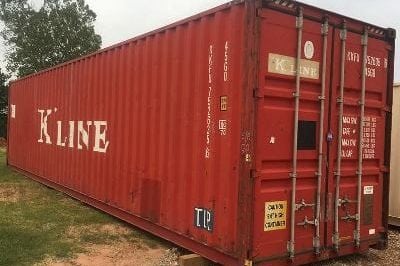Are you shopping for a WWT container? The majority of shipping containers available to the public are classified as WWT. But what exactly does this mean?
If you are in the market for a used shipping container, it’s vital to understand what WWT means. To help you understand what WWT stands for and what it means to shoppers, we’ll provide six things to know about WWT shipping containers.
6 Things to Know About WWT Shipping Containers
While it may not seem like there’s a lot to know about a refurbished container, quite a bit goes into making one “WWT.” Here are six things to keep in mind when shopping for a WWT shipping container:
1. WWT Stands for Wind and Watertight
In the cargo container industry, the term WWT stands for wind and watertight safe containers. This is the most basic level of container condition and simply means the storage container is structurally sound. A WWT container will be free of holes, leaks, and cracks and will be able to withstand heavy winds and rain.
WWT is the starting point for any further classification. From here, containers can be classified as cargo worthy or as one trip containers.
2. WWT Shipping Containers are Several Years Old
Shipping containers have a long working life before they go into used circulation. WWT containers available for sale are generally 10+ years old. However, this doesn’t mean they aren’t still in good condition. In fact, many used shipping containers are still structurally sound after 20+ years of use.
3. WWT Containers Aren’t Certified for Intermodal Shipping
WWT condition containers may not currently be cargo worthy (CWO). They have expired CSC certificates, so they can’t be used for shipping in their current condition. But, they can be repaired to CWO condition. From there, a container needs to be inspected and receive its CSC seal to be considered a cargo worthy container (CWO).
4. Expect Door Seals to Be Intact on a WWT Container
Working door seals and locking mechanisms are vital features of wind and watertight containers. Door seals are essential. They keep the container sealed tightly from the element, especially water and dust. Additionally. functioning door locking mechanisms provide a way to secure the container’s contents securely.
5. Rust and Patches are Normal on a WWT Container
Watertight cargo worthy containers vary in appearance. Some look better, and some aren’t exactly aesthetically pleasing. It’s normal for shipping containers to have surface rust or dings on the outside. They are exposed to lots of salty sea air and rain.
Containers are regularly repaired when they are in intermodal shipping circulation. A WWT container will show signs of several earlier repairs. Patches are commonplace on WWT containers.
6. WWT Containers for Mobile Storage
While Wind and Water Tight (WWT) containers may not be suitable for overseas cargo transportation in their current condition, they are a great option as affordable mobile storage solutions. Ideal for both commercial and residential use, WWT containers offer secure, wind and watertight on-site storage that is more convenient than off-site alternatives.
Read More: Shipping Container Ideas
Common Uses for WWT Containers
WWT containers open up a world of possibilities for both residential and commercial projects. Here are some of the most popular ways to repurpose them:
- Extra On-Site Storage
- Ideal For: Businesses with surplus inventory, homeowners needing additional space for seasonal items, tools, or equipment.
- Why It Works: WWT containers are secure, weatherproof, and can be delivered to virtually any accessible location.
- Tips: Choose a flat, well-drained surface for placement to ensure easy access and reduce moisture buildup beneath the container.
- Mobile Offices
- Ideal For: Construction sites, pop-up shops, remote workstations, or event spaces.
- Why It Works: The sturdy steel construction offers protection from the elements, and the interior can be easily customized with insulation, windows, and electrical outlets.
- Tips: Consider adding heating/cooling units, proper ventilation, and internet connectivity to create a comfortable, functional workspace.
- Shipping Container Homes
- Ideal For: Tiny home enthusiasts, guesthouse projects, or affordable housing solutions.
- Why It Works: WWT containers already have a weather-tight exterior, so you can focus on interior finishes like insulation, flooring, and fixtures.
- Tips: Check local zoning and building codes before you start, and plan for utilities (water, electricity, septic) early in the design process.
- Sheds or Equipment Storage
- Ideal For: Farms, landscaping businesses, or any setting where tools and machinery need to be protected.
- Why It Works: The lockable doors and steel walls keep your valuable equipment safe from theft, rodents, and weather damage.
- Tips: Install custom shelving or racks for better organization and consider adding lighting for nighttime accessibility.
WWT Shipping Containers for Sale in OK
Are you looking for a WWT container for sale? Our team at Twisted S Containers can help. We offer competitive container pricing and quality customer services.
We hand-pick our WWT containers in Oklahoma and provide free delivery within 60 minutes of our Nicoma Park container yard. Contact Twisted S Containers today!
Shopping for a Shipping Container? Read Our Beginner-Friendly Guide to Buying a Shipping Container.

